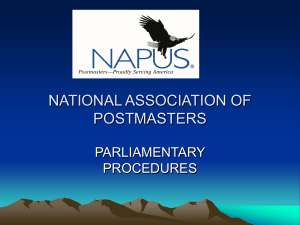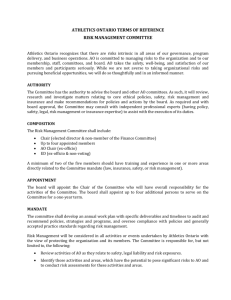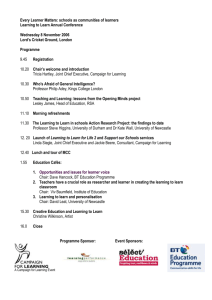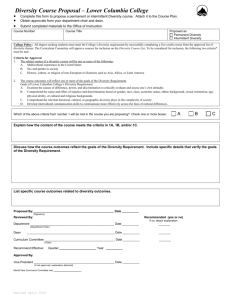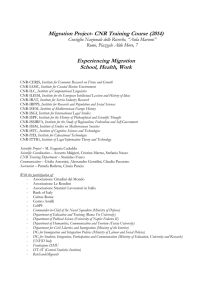HOW TO CONDUCT A MEETING (.doc)
advertisement
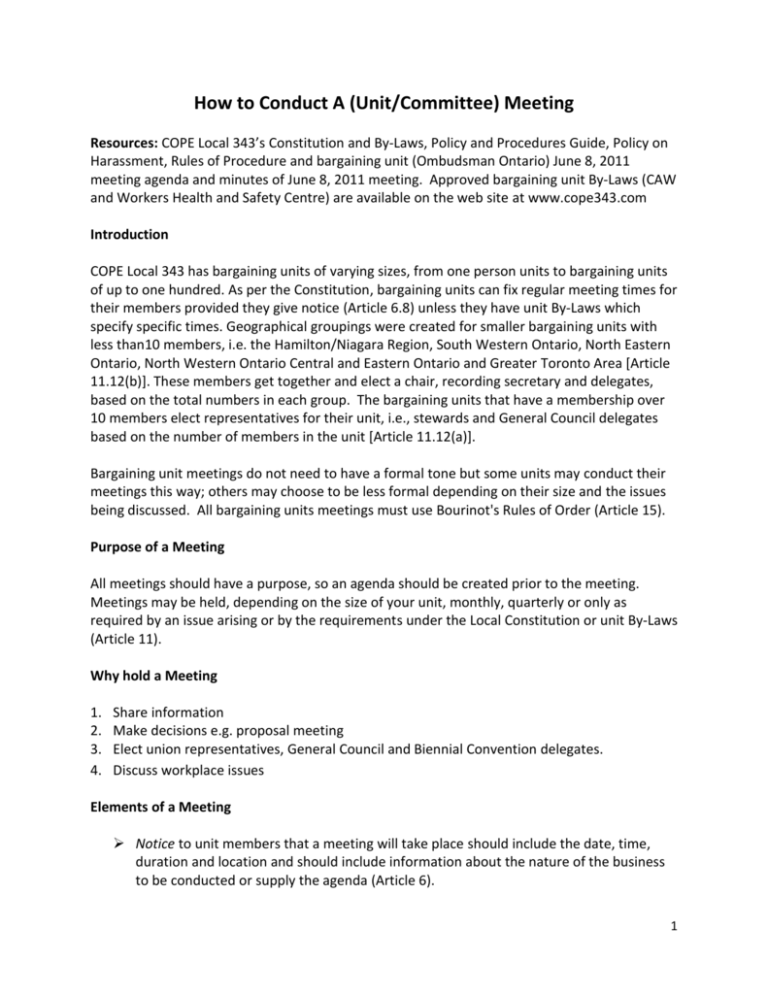
How to Conduct A (Unit/Committee) Meeting Resources: COPE Local 343’s Constitution and By-Laws, Policy and Procedures Guide, Policy on Harassment, Rules of Procedure and bargaining unit (Ombudsman Ontario) June 8, 2011 meeting agenda and minutes of June 8, 2011 meeting. Approved bargaining unit By-Laws (CAW and Workers Health and Safety Centre) are available on the web site at www.cope343.com Introduction COPE Local 343 has bargaining units of varying sizes, from one person units to bargaining units of up to one hundred. As per the Constitution, bargaining units can fix regular meeting times for their members provided they give notice (Article 6.8) unless they have unit By-Laws which specify specific times. Geographical groupings were created for smaller bargaining units with less than10 members, i.e. the Hamilton/Niagara Region, South Western Ontario, North Eastern Ontario, North Western Ontario Central and Eastern Ontario and Greater Toronto Area [Article 11.12(b)]. These members get together and elect a chair, recording secretary and delegates, based on the total numbers in each group. The bargaining units that have a membership over 10 members elect representatives for their unit, i.e., stewards and General Council delegates based on the number of members in the unit [Article 11.12(a)]. Bargaining unit meetings do not need to have a formal tone but some units may conduct their meetings this way; others may choose to be less formal depending on their size and the issues being discussed. All bargaining units meetings must use Bourinot's Rules of Order (Article 15). Purpose of a Meeting All meetings should have a purpose, so an agenda should be created prior to the meeting. Meetings may be held, depending on the size of your unit, monthly, quarterly or only as required by an issue arising or by the requirements under the Local Constitution or unit By-Laws (Article 11). Why hold a Meeting 1. 2. 3. 4. Share information Make decisions e.g. proposal meeting Elect union representatives, General Council and Biennial Convention delegates. Discuss workplace issues Elements of a Meeting Notice to unit members that a meeting will take place should include the date, time, duration and location and should include information about the nature of the business to be conducted or supply the agenda (Article 6). 1 The Agenda is used to make sure that participants are aware of the reasons for the meeting (Unit agenda). There can be standard items on an agenda. Some units have a set agenda for all meetings, as does the Local Executive Board (Unit By-Laws and Policy and Procedures). The bargaining unit Recording Officer or Chairperson/Chief Steward should ask members for additional agenda items in advance of the meeting. The agenda may or may not be given in advance of the meeting. If the meeting is called for a specific purpose, then at the outset of the meeting the Chair should clearly state the primary reason for the meeting. Harassment Policy may be read or handed out at the beginning of the meeting.(Policy and Procedures Guide and Policy on Harassment) Previous Minutes if taken must be handed to the attendees for review. A copy may be given to every member prior to any meeting so that they are informed of events and decisions made at the last meeting. A copy of the minutes should be forwarded to the Staff Representative, especially if the Rep was not in attendance. The Chair's Responsibilities are, but not limited to, starting the meeting on time, ensuring that the meeting runs smoothly by keeping people on topic, ensuring that members are respected, not interrupted while speaking, create a speakers list if required, and perhaps a time limit to ensure that the meeting is kept on track. Punctuality is important for everyone attending a meeting. It is important that people be on time and that the meeting starts when it's supposed to. Waiting for latecomers, (unless you don't have a quorum) is disrespectful to others who have made it on time. It's also important for the meeting to end on time and members appreciate if the meeting ends earlier than scheduled. Quorum is the minimum number of members required to be able to conduct business. The number for quorum is usually set out in the Constitution (Article 6) or in unit ByLaws. Once quorum has been achieved then the meeting should begin, should members leave the proceedings the meeting can continue unless challenged by someone in the room. This meeting now becomes an information meeting and no voting on any issues can take place since there is no longer a quorum. Items that need to be voted on are tabled until the next meeting. 2 The Voting Methods. The Labour Relations Act requires that strike and ratification votes must be conducted by secret ballot. The Chair can determine the process to be used for all other votes, including by voice, show of hand, standing, and ballot. Regardless of the procedure used, the vote must be, and must be seen to be, carried out with absolute fairness. Recording Minutes of a meeting is important in order to record history, to inform persons not in attendance and as a reminder for items that were deferred or carried forward to the next meeting. Topics of discussion, motions, decisions and action items must be recorded along with the names of the attendees and those absent to keep an accurate record (unit minutes). Adjourning a meeting at the scheduled time is important. If there are still important matters to be discussed and you still have quorum, you may carry a meeting past your ending time. However, you should get the agreement from the membership to continue. If there is no consensus, defer any unfinished items on the next meeting. Prior to adjourning the meeting, members need to have a clear understanding of what has taken place and what specific actions and time lines that may need to be carried out prior to the next meeting. This information should then be communicated in writing to the members who are going to do the action items, ensuring they understand what needs to be accomplished and if applicable, what remains to be done by whom and when. How to Conduct a Meeting (See Rules of Procedure) The Chair (usually the President or chief steward/Chair person) is the person designated to ensure that information is received and/or to facilitate discussion, help the group make decisions, and resolve problems. The Chair does not participate in debate, does not vote except in the case of a tie vote. The Chair can give information on the subject or issue being discussed. In less formal meetings, while ensuring the efficient conduct of business, the Chair can participate in discussion but they cannot vote on any issue unless it is to break a tie vote. The only exception where the Chair can vote is if it is during a strike vote or during an election. If the Chair wishes to propose a motion, the Chair must temporarily step down from the position of Chair, have someone else continue with the proceedings, then make the motion and not return to the position of Chair until the motion has been decided. The Chair can keep a speakers list or they can have another person keep the list for them. The Chair should not allow a member to speak to the same issue twice until everyone else wishing to speak has spoken to the issue once. When it appears that everyone has had an opportunity to speak, the Chair will call an end to the debate and conduct the vote. 3 The Chair does not allow the speaker to be interrupted, except if a member calls for: 1) Point of information To request for information from the current speaker 2) Point of order To address breaches of rules or inappropriate remarks 3) Point of privilege This should only be used prior to debate on an issue. For example, if a member wants to bring a point of privilege to the floor they can do it just as the meeting is going to adjourn, or prior to another issue being discussed or upon the meeting resuming from a break. Matters that are considered point of privilege are: To address situations affecting personal comfort (i.e., ventilation, noise, etc.) To identify that a confidential subject is being introduced in a public forum To seek permission to present a motion of an urgent nature Rules of Order/Parliamentary Procedure Parliamentary procedure protects the rights of people to join together to accomplish common goals and enables them to debate and take action in a fair manner with the least amount of controversy. Parliamentary procedure also permits a group to feel that the business of the meeting was conducted in a proper manner and that process used can stand up to any later challenge. All members are equal and their rights are equal. Those rights are: To attend the meeting To make motions and speak in debate To nominate To vote, and To hold office 4 Motions A motion brings business before the group by proposing that the group take a certain action or that it express a specific opinion. Main Motion - Requires a mover and a seconder to start the discussion on an issue. The custom is for the mover to speak to the motion, i.e., provide a rationale and basic information. Debate - Remarks are to be directed to the Chair on the subject of the motion. They must be courteous in language and deportment. Avoid personalizing. Do not allude to others by name or motive. Amendments - More than one amendment can be made. A vote is held whether to accept the proposed amendment. If an amendment is rejected, a vote is taken on the original motion. Withdrawal - Only the original mover can withdraw his/her motion Vote - Should the motion pass, it becomes a decision of the meeting and is written as a resolution in the meeting’s minutes, or other record. It must indicate the mover and the seconder for the motion. Reconsideration - The same subject cannot be raised again during that meeting. If a member or group thinks it necessary to change or rescind the motion, they have to serve notice of intent to change this matter at the next meeting. At the next meeting, they would present their motion to reconsider. For example, a motion is passed to change the travel policy. However, some members believe that it discriminates against members who do not drive. Notice of intent to reconsider the motion is given prior to the next meeting. At the next meeting, the members have to vote on a motion for reconsideration. If successful (usually by two-thirds majority), the new motion is made/seconded, the issues are debated and the motion is voted upon. COPE343 5




